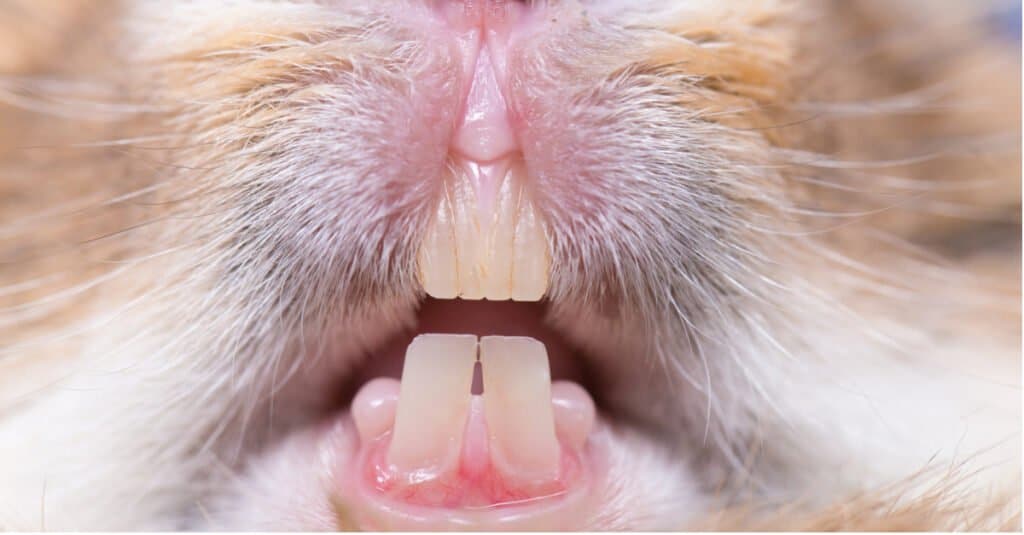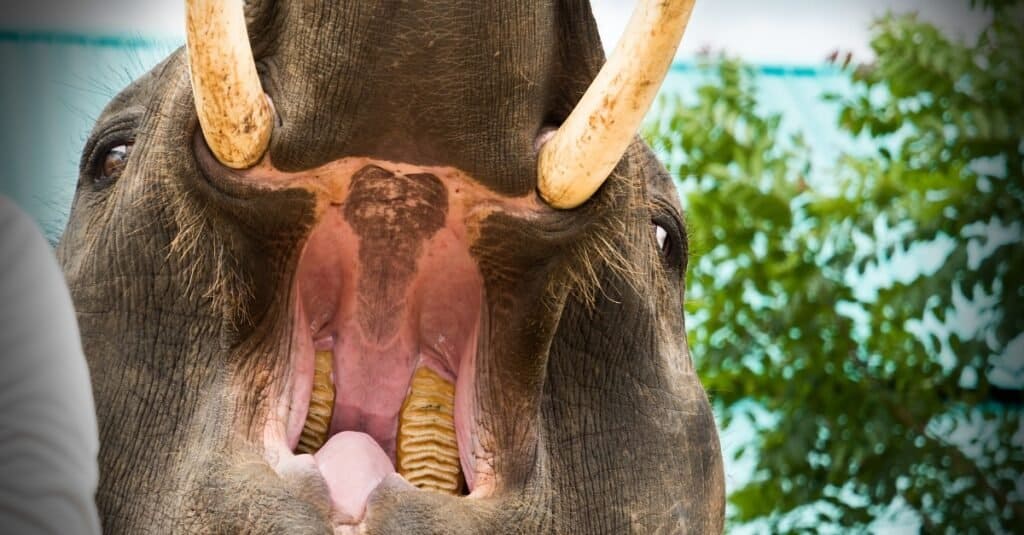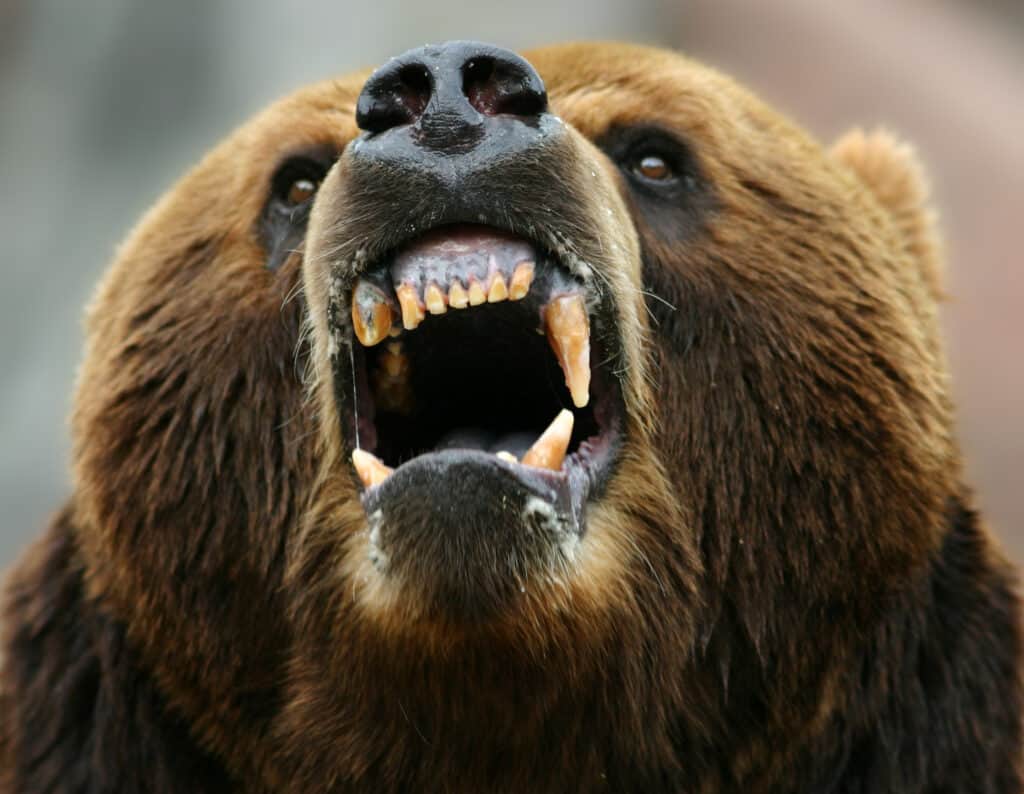While they are often overlooked, teeth play a significant role in allowing us to chew and digest food, protect our gums, and even help us articulate while speaking! It is important to take good care of your teeth, as they are the only part of the body that is not comprised of living tissue, meaning they cannot regenerate. Is this the same for animal teeth? Keep reading to find out!
Some animals, such as horses and rabbits, have teeth that grow continuously throughout their lives and often must be filed down and maintained. Adult humans have a maximum of 32 teeth, but animals can have many more, like horses, who have 44 teeth.
While all teeth play a role in chewing, they have different shapes and sizes that allow animals to break apart food differently depending on their location in the mouth.
Let’s explore animal teeth and their specific functions.
Animal Teeth: Incisors

Rabbits have six incisor teeth.
©Roselynne/Shutterstock.com
Located at the front of the animal’s mouth, incisors are longer teeth with a flat edge, useful for cutting through food and breaking it apart as it enters the mouth. They are bigger in animals with largely plant-based diets, as they help cut through softer and more fragile foods like fruits and vegetables. Incisors are common in most mammals but vary greatly in number. For example, humans have eight, dogs, cats, pigs, and horses have 12, and opossums have 18.
Some mammals, such as armadillos, have no incisors. While they only have two, elephants probably have the most recognizable incisors – their tusks! Elephants use their tusks for defense, digging, and gathering food. Carnivores also have incisors, but they are much smaller and often used for scraping meat off a bone rather than tearing through it.
Canine Teeth

Canine teeth are typically the largest in the mouth, stretching past the incisors with a sharp, pointed end.
©iStock.com/Ian Dyball
Also known as the cuspid or eye tooth, canine teeth are located behind the incisors in most mammals. These teeth are typically the largest in the mouth, stretching past the incisors with a sharp, pointed end. Canine teeth evolved in mammals to allow them to tear through tough substances like meat and flesh efficiently after being broken into smaller pieces by the incisors. Carnivores and omnivores rely heavily on their canine teeth, as they ensure that the animals will not choke on large, tough pieces of meat.
While elephants’ tusks are technically incisors, animals like wild boar and walruses are designated as canine teeth due to how they curve down from the mouth rather than extend out of it. Another difference between canine teeth and incisors is that while the number of incisors animals have greatly varies, canine teeth come only in sets of four: two at the top of the mouth and two at the bottom. Depending on the length, these teeth can also affect an animal’s range of chewing when consuming food.
Animal Teeth: Premolars
The premolars are located just behind the canine teeth in the mouth. They are also called bicuspid teeth, as they help move food from the cuspids (canines) to the molars in the back of the mouth. These teeth vary greatly in size depending on the type of animal and are wide and rugged at the top, passing the food through grooves to further pull it apart before it reaches the molars.
Premolars are often slightly smaller than molars, serving more as transitional teeth than having any specific purpose or function. Most mammals have eight premolars, with four located on their upper jaw and four on their bottom jaw. However, marsupials such as koala bears and kangaroos typically have only two to three premolars. These are the least specialized teeth in the mouth but are still incredibly helpful in the food breakdown process.
Molars

An
elephant
opens its mouth. If you look closely, you can see its molars!
©iStock.com/Roman_Baiadin
Molars are the largest and most powerful teeth in the mouth. Located at the very back of the jaw, these teeth are the final line of defense against choking, meaning they have to break up the food into small enough pieces to swallow and be digested. They are relatively flat on top, with four to five raised indentations called cusps that further tear into pieces of food. Molars are often larger and wider in herbivores to grind down plants and leaves, while carnivores like lions have less due to a different chewing pattern in the front of their mouths.
Humans have a total of 12 molars, with four sets of traditional molars and two pairs of wisdom teeth. Carnivores like tigers, however, have only two molars compared to 12 premolars.
Are There Different Types of Teeth in Non-mammals?
While all of these teeth are prevalent in mammals, fish have them too! Just like mammals, the quantity of each type of tooth varies between species. It will also vary according to the diet and habitat of the fish. Fish can have incisors, canine teeth, and molars. In addition, some have large plates in their mouths instead of traditional rows of teeth. Most common in deep sea fish called chimaeras, these plates are wide, rugged surfaces that compress together to break apart food. These fish feed off of other bottom-dwelling creatures such as octopi, crabs, and mollusks. They utilize electroreception to hunt down their prey in the dark and then consume them with their three rows of jagged tooth plates.
Do Fish Have Teeth?
These fish likely never developed actual teeth due to the lack of bones in their prey. This allowed them to consume these creatures without much effort. Another type of fish with unusual teeth is the shark. The first unique type of shark tooth is the dense flattened tooth. This tooth is often found in sharks that dwell near the ocean floor. These teeth are useful for crushing prey like crustaceans and bivalves. They are most common in the angel and nurse shark species.
Shark Teeth
Other species, like bull sharks, have sharp, needle-like teeth. These pointy fangs are helpful for catching prey that is slippery, such as fish and even other smaller sharks. The infamous great white shark has lower teeth that are pointed up towards triangular-shaped teeth on the upper jaw.
These teeth have serrated edges that can easily slice through fish and occasionally large mammals. Similar to canine teeth, these jagged weapons can tear through almost anything that comes in the great white’s way. The final type of shark tooth is the non-functional tooth. These are small teeth belonging to species like the whale shark, which filter feeds rather than hunt for prey.
Do Amphibians Have Teeth?
Amphibians like salamanders and frogs also have teeth, but they differ greatly from mammal and shark teeth. These creatures have what are called vomerine teeth. These teeth protrude from the upper jaw and are used to hold onto their prey while they consume it. Because amphibians consume their food whole, they don’t need teeth to break food apart into smaller, more digestible pieces.
Finally, reptiles have three distinct types of teeth not seen in mammals, fish, or amphibians. Acrodont teeth are incredibly weak and are fused to the jaw bone, making them susceptible to damage and breakage. Pleurodont teeth are very common in lizards and are slightly stronger as they are internally attached to the jaw bone. The last type of tooth in reptiles is only present in crocodiles and is called the thecodont tooth. These teeth are incredibly strong, as they are used to bite through large fish and mammals.
Animal Teeth: Conclusion

Different species have evolved to have varying types and sets of teeth depending on their dietary needs and native environments.
©PhotoBarmaley/Shutterstock.com
Over time, different species have evolved to have varying types and sets of teeth depending on their dietary needs and native environments. While there are only four main classifications of teeth across millions of species, each animal can utilize their teeth optimally to consume food and keep itself healthy.
Taking great care of your teeth is important because they impact general well-being more than most people realize.
The photo featured at the top of this post is © iStock.com/Ian Dyball
Thank you for reading! Have some feedback for us? Contact the AZ Animals editorial team.






